From Quotas to Payouts: One Connected Incentives Ecosystem
Most companies treat quota setting, territory changes, crediting, and incentive payouts as separate projects—each with its own spreadsheets, approvals, and handoffs. This page walks you through how a mature organization treats these as one governed loop, with clear ownership, auditability, and minimal friction.
Whether you're a Sales Ops leader, Finance executive, or CXO, understanding this ecosystem helps you ask better questions about your incentive programs and spot where your current process breaks down.
Scroll below to explore how this works in practice →
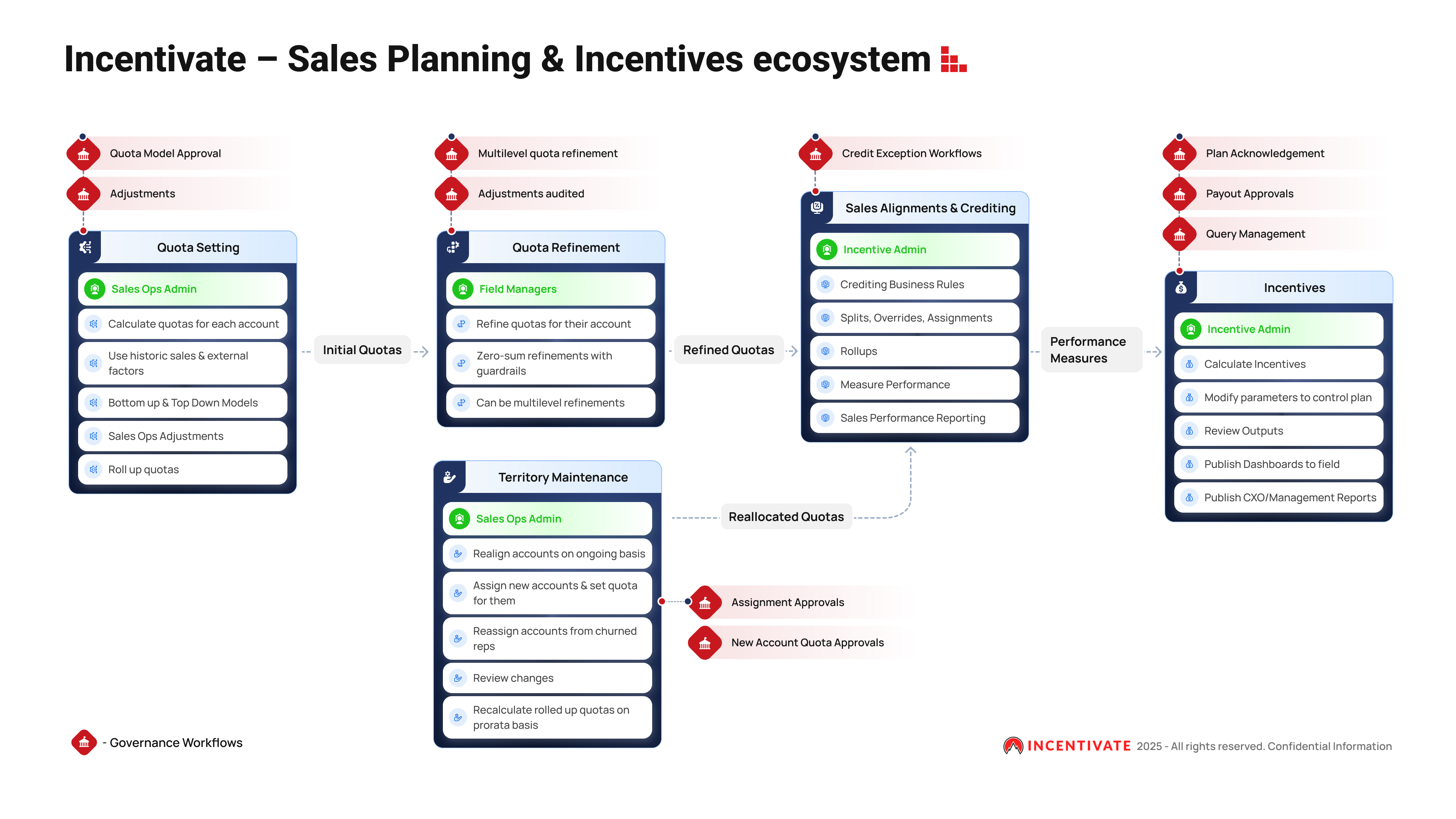
Step 1: From Strategy to Initial Quotas
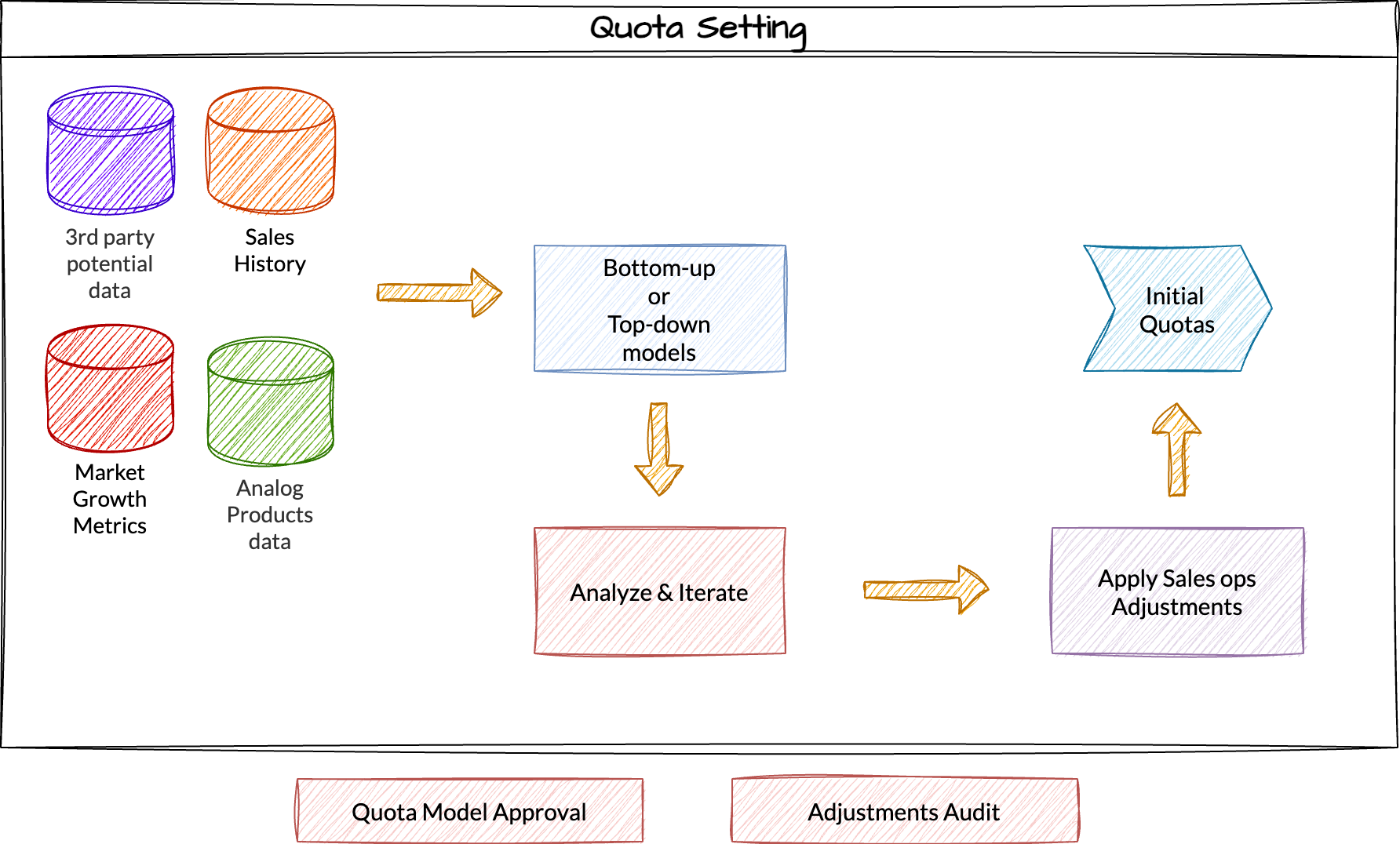
The quota-setting phase is where strategy meets mathematics. Sales Ops Admins work with leadership to translate business goals into individual quotas—and this is where the first layer of governance kicks in.
Using History and External Factors
Most quota models start with historical data. How much did each rep sell last year? How much did each account grow? But history alone doesn't account for market changes, new competitive dynamics, or strategic pivots. The best quota models let you layer in external factors—macroeconomic indices, seasonal adjustments, account potential—while keeping an audit trail of *why* each adjustment was made.
Bottom-Up vs. Top-Down: Best-of-Both Worlds
Some organizations use a top-down approach: leadership sets a total revenue target, then distributes it down the hierarchy. Others use bottom-up: aggregate team quotas to validate feasibility. The strongest programs do *both*. They calculate quotas bottom-up based on account potential and rep capability, then compare to the top-down target. If there's a gap, they identify where assumptions differ—and make conscious adjustments with documentation.
Hierarchy Rollups and Adjustments
Quotas roll up: individual rep quotas sum to team quotas, team quotas sum to region quotas, and so on. But at each level, managers need the ability to fine-tune. A regional VP might say, "I know the math says my region should hit $10M, but I know my team better—$9.5M is realistic, and here's why." These adjustments should be *structured*—recorded, justified, and subject to approval—not hidden in a black box or buried in email threads.
Governance at This Stage
Quota Model Approval and Adjustments Audited aren't bureaucracy—they're guardrails. When finance signs off on the quota model, they're confirming that the methodology is sound and the numbers are defensible. When you maintain an audit trail of quota adjustments (who changed it, when, why), you build trust. Later, when a rep says "My quota was unfair," you have the conversation—not a spreadsheet hunt.
How Incentivate supports this: Our platform lets you combine historical data, external factors, and business judgment in one model, then automate the rollups. Every adjustment is logged. And because the model lives in one system—not a dozen spreadsheets—there's one source of truth for leadership, Sales Ops, and reps.
Step 2: Quota Refinement
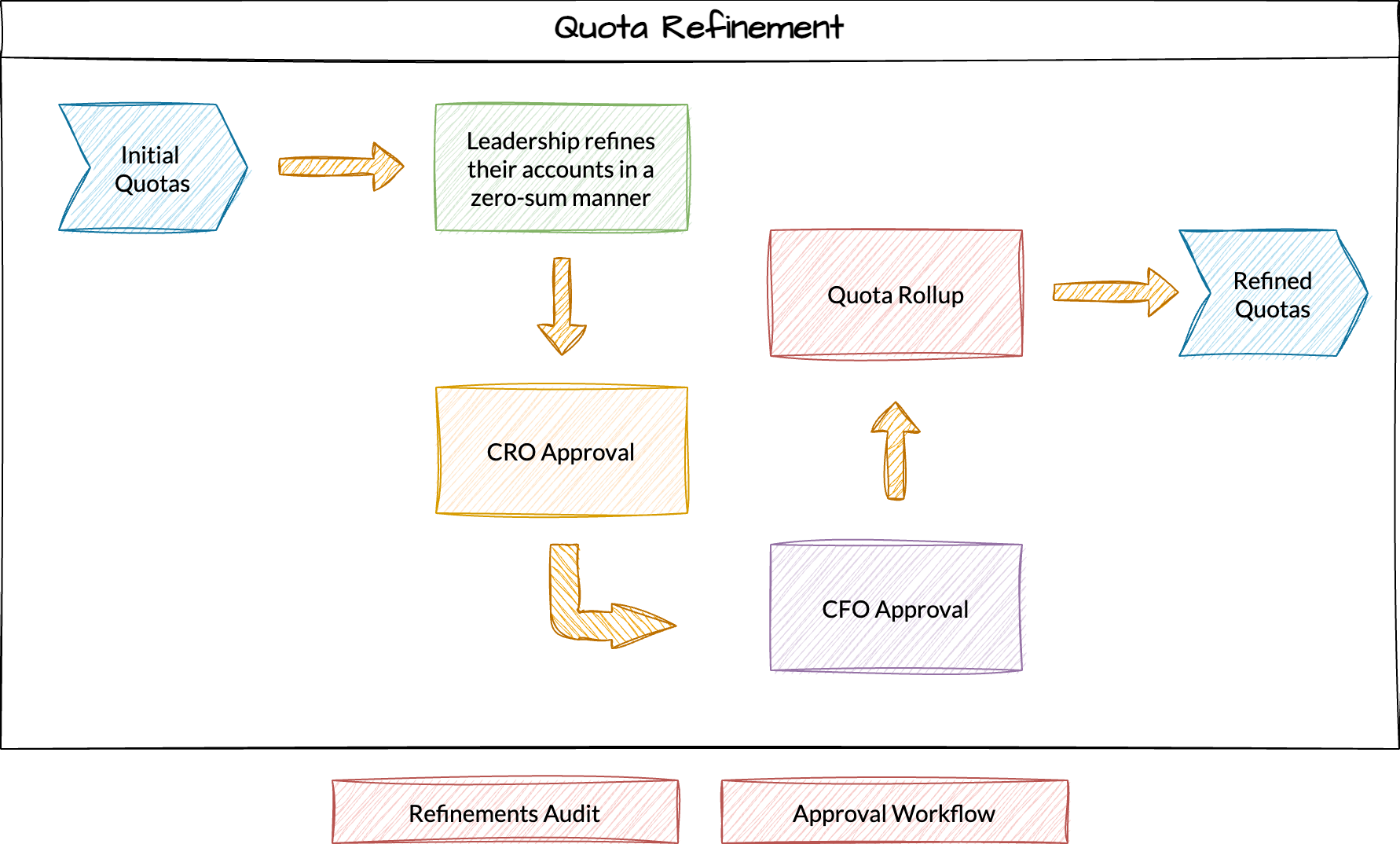
After the initial model is published, field managers take over. They know their accounts intimately. A manager might say, "Account ABC is growing faster than history suggests; let's increase this rep's quota." But here's the critical detail: that increase doesn't happen in isolation. When one rep's quota goes up, something else must adjust—either another rep's quota comes down, or the total team quota increases, or the adjustment is justified with new business.
This is where guardrails matter. A good system lets managers refine quotas but prevents them from gaming the system—e.g., arbitrarily slashing quotas to make themselves look good, or hoarding high-quota accounts. Multi-level approvals (first-line manager → area manager → regional manager) ensure that refinements are fair and defensible.
Governance in Motion
Multilevel Quota Refinement and Adjustments Audited represent an ongoing governance loop, not a one-time project. Every change is visible, traceable, and justified. This matters for fairness (reps know how their quotas are set) and audit (finance can explain why quotas change).
How Incentivate supports this: We design implementations so Sales Ops can manage quota refinements without opening IT tickets, while still retaining program governance and audit trails. Managers can refine quotas within guardrails, and the system logs every change.
Step 3: Territory Maintenance
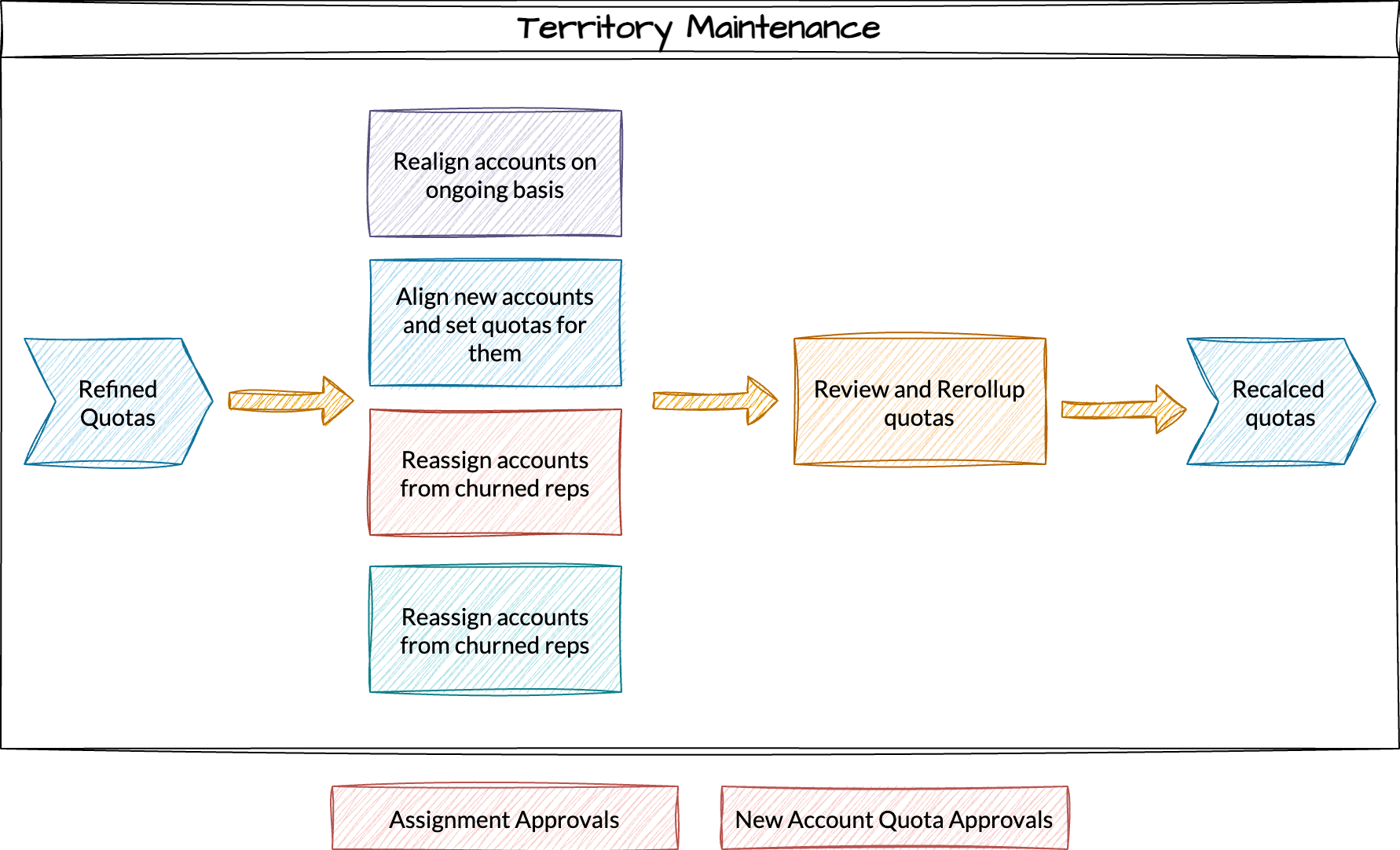
A sales organization is never static. Reps leave, accounts churn, new accounts arrive, and your best performer gets promoted. Each of these changes triggers a quota reallocation. When a rep leaves mid-year, their accounts need to be reassigned. If Account X is reassigned from Rep A to Rep B, what happens to their quotas? The best answer: they adjust prorationally. If Rep A had $1M quota for the year and Account X (worth 20% of their book) is reassigned, they drop to $800K quota. Account X gets a new quota assigned based on when it transferred and its potential.
This sounds simple, but in fragmented systems, it becomes chaos. New Account Quota Approvals and Assignment Approvals ensure that when territories shift, quotas are recalculated correctly and signed off by the right people. No cherry-picking, no disputes after the fact.
Prorated Quotas and Reallocations
Territory maintenance means treating quotas as a living system. When accounts move, quotas adjust automatically and proportionally. When new accounts are added, quotas are recalculated. When reps leave, their remaining accounts and quotas are rebalanced. All of this happens transparently, with audit trails and approvals, so that no one has surprises at payout time.
How Incentivate supports this: Our platform calculates prorated quotas automatically when accounts move, and recalculates rollups across the hierarchy. Every assignment change is tracked and approved, ensuring clarity for reps and managers alike.
Step 4: Sales Alignments & Crediting

Once quotas are set, the Incentive Admin faces a new challenge: how do we credit revenue to reps? This sounds simple if you have one rep per account, but in most organizations, sales is collaborative. Account teams, inside sales supporting field teams, channel partners, and implementation teams all contribute. The crediting layer decides who gets credit for what.
This is where business rules, splits, and overrides come in. You might have rules like: "Field reps get 80% credit on new business, implementation gets 20%." Or: "Territory owners always get 100% credit, even if another rep influenced the deal." These rules must be consistent with the quota and territory structure—if Account X's quota belongs to Rep A, the credit rules should align with that assignment.
Credit Exception Workflows are the safety valve. Sometimes a rule doesn't apply. A rep pulled off a complex deal that doesn't fit the standard split; a customer credit card issue delayed payment and distorted when revenue was recognized; or a special project deserves special credit. These exceptions need to be tracked, approved, and documented—otherwise they become the norm and your crediting rules become useless.
How Incentivate supports this: We manage crediting logic with precision, handling splits, overrides, and exceptions in a traceable way. Every credit decision is documented, so reps understand how their performance is measured.
Step 5: Performance Reporting & Payouts
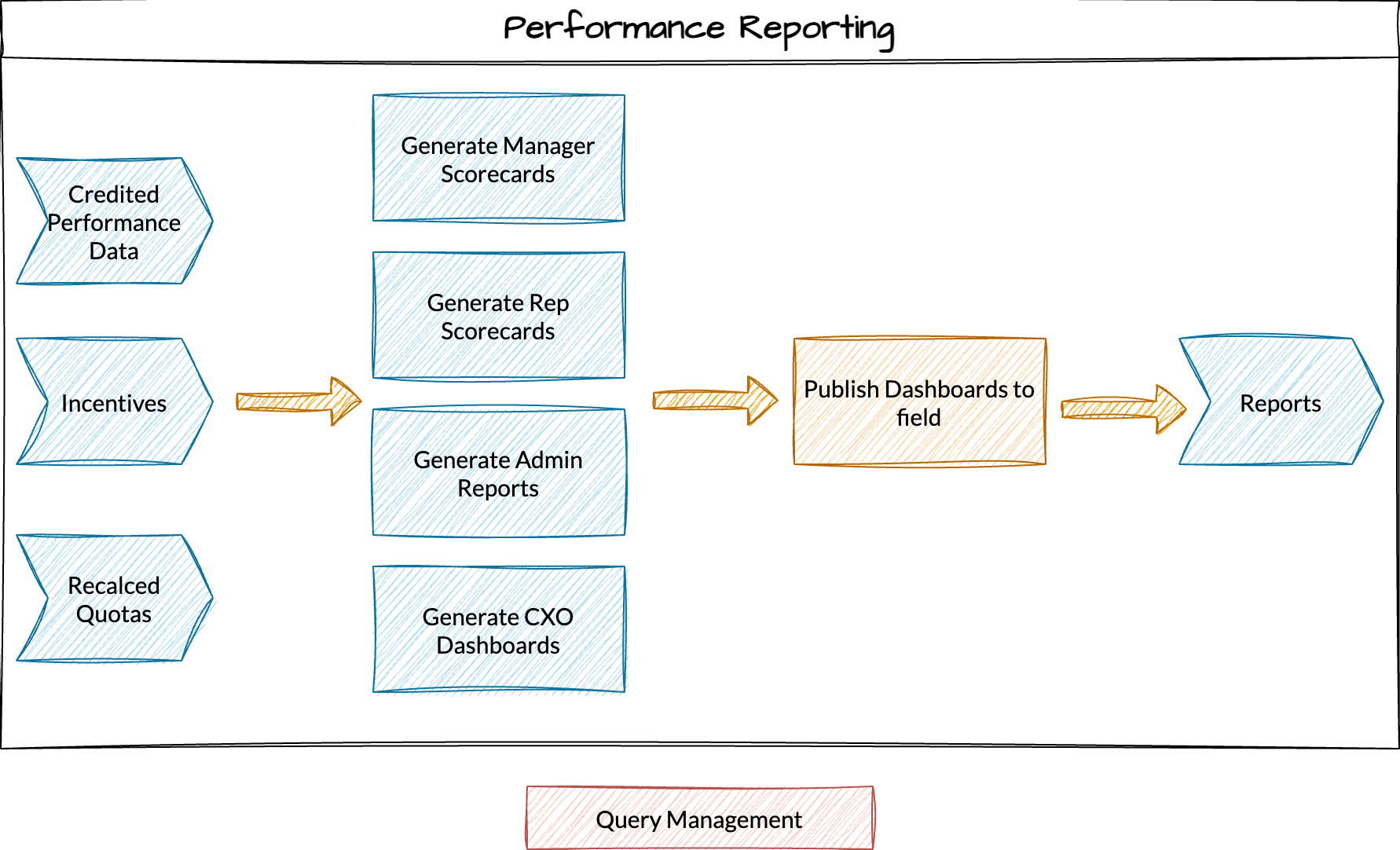
With quotas and credits in place, calculating incentives and reporting results is the culmination of the entire ecosystem. The system compares actual sales to quota, applies the incentive plan (tiered rates, accelerators, caps/floors), and calculates what each rep earns.
From Measures to Payouts
Before payouts go live, leadership wants to see "what if" scenarios. What if we increased the accelerator rate by 2%? What's the cost impact? Can we afford it? Before paying reps, finance and leadership review the payout results. Are there outliers? Do payouts match expectations? This is Plan Acknowledgement and Payout Approvals in action—reps know what they're being paid on, and leadership has visibility before dollars leave the bank.
Dashboards & Insights
After payouts are published, reps need to see their results. Why did I earn that? Which deals moved me to the next tier? Management needs different dashboards: cost-of-sales analysis, tier distribution, anomalies. CXOs want one-page summaries: total variable spend, cost-of-sales ratio, rep productivity. Query Management ensures that when reps question their payouts, there's a structured way to investigate, explain, and resolve—without firefighting.
How Incentivate supports this: We deliver comprehensive reporting dashboards for reps, managers, and leadership. Our QA process and delivery discipline mean fewer month-end fires. Reps and managers get transparency into what they've earned and why. Finance gets confidence in the numbers before payout.
Governance Workflows: The Invisible Backbone
If you map out the ecosystem, you'll notice red icons and lanes running above and below the main blocks. These represent the governance layer—the approvals, audit trails, SLAs, and controls that overlay every stage. They're not optional compliance overhead; they're the difference between a program that runs smoothly and one that lives in firefighting mode.
What Governance Actually Does
- Quota Model Approvals: Leadership signs off that the methodology is sound.
- Multilevel Quota Adjustments & Audits: Every change is recorded, justified, and approved by the right level of manager.
- Credit Exception Workflows: Special credit requests are tracked and approved, not buried in email.
- Plan Acknowledgement: Reps confirm they understand their incentive plan before month one of the fiscal year—no surprises later.
- Payout Approvals: Finance and leadership review payout results before reps are paid, catching errors and outliers.
- Query Management: When a rep questions their payout, there's a structured way to investigate, explain, and resolve.
In fragmented systems, these are email threads, spreadsheet notes, and tribal knowledge. In a governed ecosystem, they're tracked, timestamped, and documented. When an auditor asks, "How did you set quotas for this region?" you have an answer. When a rep challenges a payout, you can trace every step.
Implementation & Delivery Philosophy
Getting governance right requires more than software. It requires:
- Comprehensive Requirement Gathering: Understanding your current process, pain points, and stakeholder needs before building.
- Rigor in Testing: Validating that rules, calculations, and approval workflows work as designed, especially edge cases.
- Time-Bound Delivery: Getting the system live on a predictable schedule, so the organization can start benefiting from governance immediately.
- Stress-Free Month-End: The real test is whether your team is calm during payout cycles. If month-end is chaos, something in the governance layer isn't working.
How Incentivate supports this: We've built comprehensive governance capabilities into the platform. From requirement gathering through go-live and beyond, we stress-test implementations so that your month-end is predictable and the data is trustworthy.
What This Looks Like in the Real World
Consider a global financial services firm with 500+ reps, 50+ managers, and complex commission structures. Two years ago, quota changes took 6 weeks, territory reassignments triggered payout disputes that took months to resolve, and month-end payroll was a three-day firefight. Quotas lived in one spreadsheet, credits in another, incentive calculations in a third.
After implementing a governed ecosystem, quota revisions take 2 weeks. Territory changes are rebalanced automatically, and prorated quotas are clear to everyone. Payout month-end is a calm, predictable process because the rules are consistent and the system is auditable. Reps trust the payouts because they can see the logic. Finance trusts the numbers because they've approved the methodology and tested the calculations.
Key Benefits in Plain English
- Fewer surprises for reps: Quotas, credit rules, and payout calculations are transparent and defensible.
- Less firefighting for Sales Ops and Finance: Processes are standardized and automated, freeing teams to focus on strategy.
- Better confidence for leadership: You can trust the numbers because they're auditable and tested.
- Stronger compliance posture: Documentation and audit trails make regulatory reviews straightforward.
If you'd like to see how your current processes map onto this ecosystem, we can walk through your existing spreadsheets and workflows together. We'll help you identify where quotas, credits, or governance break down—and what a more integrated approach could look like.